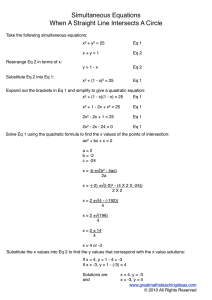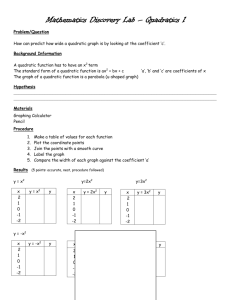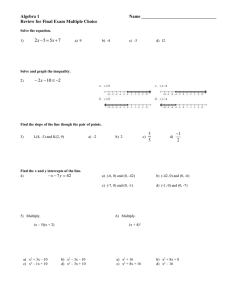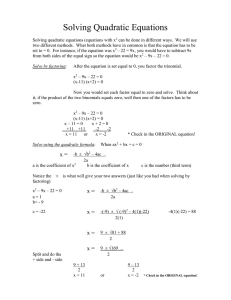(Core 1) Revision Sheet
advertisement
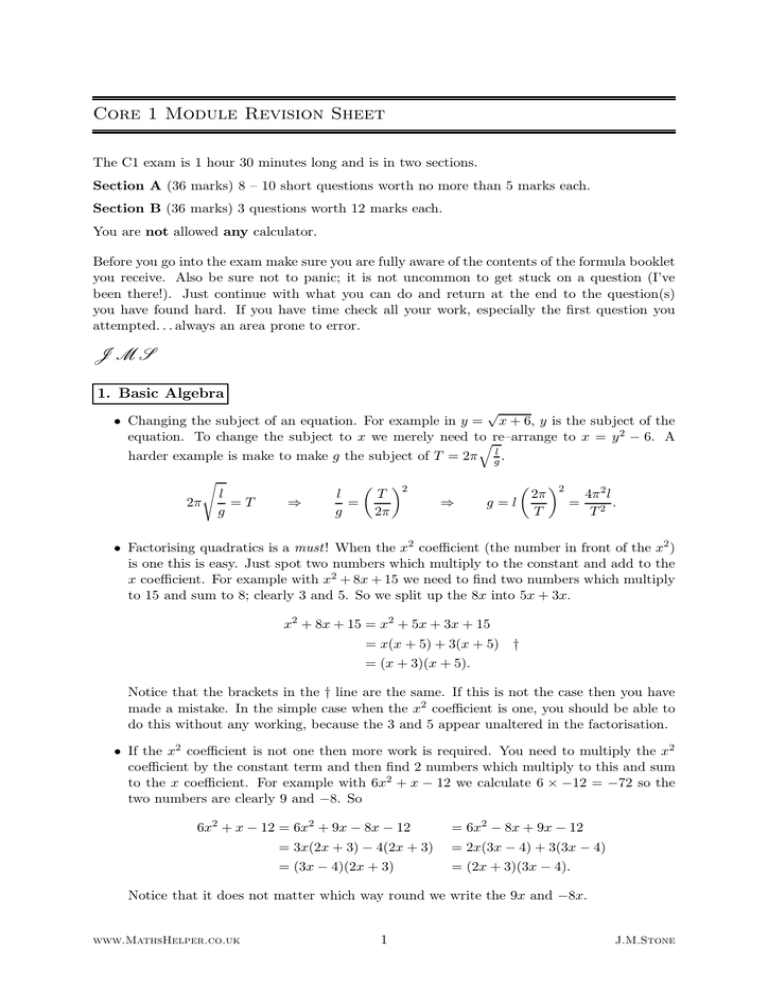
Core 1 Module Revision Sheet The C1 exam is 1 hour 30 minutes long and is in two sections. Section A (36 marks) 8 – 10 short questions worth no more than 5 marks each. Section B (36 marks) 3 questions worth 12 marks each. You are not allowed any calculator. Before you go into the exam make sure you are fully aware of the contents of the formula booklet you receive. Also be sure not to panic; it is not uncommon to get stuck on a question (I’ve been there!). Just continue with what you can do and return at the end to the question(s) you have found hard. If you have time check all your work, especially the first question you attempted. . . always an area prone to error. JMS 1. Basic Algebra √ • Changing the subject of an equation. For example in y = x + 6, y is the subject of the 2 equation. To change the subject to x we merely need to qre–arrange to x = y − 6. A harder example is make to make g the subject of T = 2π gl . 2π s l =T g ⇒ l = g T 2π 2 ⇒ g=l 2π T 2 = 4π 2 l . T2 • Factorising quadratics is a must! When the x2 coefficient (the number in front of the x2 ) is one this is easy. Just spot two numbers which multiply to the constant and add to the x coefficient. For example with x2 + 8x + 15 we need to find two numbers which multiply to 15 and sum to 8; clearly 3 and 5. So we split up the 8x into 5x + 3x. x2 + 8x + 15 = x2 + 5x + 3x + 15 = x(x + 5) + 3(x + 5) † = (x + 3)(x + 5). Notice that the brackets in the † line are the same. If this is not the case then you have made a mistake. In the simple case when the x2 coefficient is one, you should be able to do this without any working, because the 3 and 5 appear unaltered in the factorisation. • If the x2 coefficient is not one then more work is required. You need to multiply the x2 coefficient by the constant term and then find 2 numbers which multiply to this and sum to the x coefficient. For example with 6x2 + x − 12 we calculate 6 × −12 = −72 so the two numbers are clearly 9 and −8. So 6x2 + x − 12 = 6x2 + 9x − 8x − 12 = 3x(2x + 3) − 4(2x + 3) = (3x − 4)(2x + 3) = 6x2 − 8x + 9x − 12 = 2x(3x − 4) + 3(3x − 4) = (2x + 3)(3x − 4). Notice that it does not matter which way round we write the 9x and −8x. www.MathsHelper.co.uk 1 J.M.Stone • For quadratics that cannot be factorised we need to use the formula. For ax2 + bx + c = 0 the solution is √ −b ± b2 − 4ac 1 . x= 2a b2 − 4ac is the discriminant. If it is positive then there are two distinct roots. If it is zero then there exists only one root and it is repeated. If it is negative then there are no roots.2 • Completing the square. All about halving the x coefficient into the bracket and then correcting the constant term. For example x2 − 6x + 10 = (x − 3)2 − 9 + 10 = (x − 3)2 + 1. If the x2 coefficient isn’t one then need to factorise it out. For example −2x2 + 4x − 8 = −2[x2 − 2x + 4] = −2[(x − 1)2 − 1 + 4] = −2[(x − 1)2 + 3] = −2(x − 1)2 − 6. From this we can find the maximum or minimum of the quadratic. For y = −2(x − 1)2 − 6 it is when x = 1 (to make the bracket 0) and therefore y = −6. In this case (1, −6) is a maximum due to negative x2 coefficient. • Simultaneous equations. Use either substitution or elimination. For example 1. Elimination; 2x+3y=7 3x+y=7 ⇒ 6 + y = 7 ⇒ y = 1. 2x+3y=7 9x+3y=21 . Subtracting to get 7x = 14 ⇒ 2x+3y=7 3x+y=7 ; x = 2. Then 2. Substitution; y = 7 − 3x. Put this into first equation to get 2x + 3(7 − 3x) = 7 −7x = −14 ⇒ x = 2 ⇒ y = 7 − 6 = 1. ⇒ • You must also know how to handle algebraic fractions and how to write two algebraic fractional expressions as one fraction. The general rules are ad ± bc a c ± = b d bd Therefore to write x − x x+1 x− and a c ac × = . b d bd as a single fraction we do the following x x x(x + 1) − x x2 x = − = = . x+1 1 x+1 x+1 x+1 2. Co-ordinate Geometry Lines x1 + x2 y 1 + y 2 , . • Mid point of (x1 , y1 ), (x2 , y2 ) is 2 2 p • Length from (x1 , y1 ) to (x2 , y2 ) is (by Pythagoras) (x2 − x1 )2 + (y2 − y1 )2 . Be careful about negatives! Remember (2 − (−3))2 = (2 + 3)2 . • Gradient is defined to be difference in y y2 − y1 = . difference in x x2 − x1 • Two lines with gradients m1 and m2 are at right angles (perpendicular) if m1 × m2 = −1. So if a line has gradient −3 then the line perpendicular to it has gradient 31 . √ b2 −4ac . This is not (as one student thinks) x = −b ± 2a 2 Actually there are no real roots but there are two complex/imaginary roots (Further Mathematicians only!). 1 www.MathsHelper.co.uk 2 J.M.Stone • Lines can be written in many forms, the most common being y = mx + c and ax + by = c. Any form can be converted to any other. For example write 3x − 2y = 4 in the form y = mx + c. 3x − 2y = 4 2y = 3x − 4 y = 32 x − 2. • Given two points (x1 , y1 ) and (x2 , y2 ) the line connecting them is given by x − x1 . x2 − x1 y − y1 = y2 − y1 • Given one point (x1 , y1 ) and a gradient m the line is given by y − y1 = m(x − x1 ). Circles • Circles with centre (0, 0) and radius r are expressed by x2 + y 2 = r 2 . • Circles with centre (a, b) and radius r are expressed by (x − a)2 + (y − b)2 = r 2 . • By ‘completing the square’ you can convert circles of the form x2 + y 2 + αx + βy + γ = 0 into the form (x − a)2 + (y − b)2 = r 2 . For example x2 + y 2 + 6x − 4y + 9 = 0 x2 + 6x + y 2 − 4y + 9 = 0 (x + 3)2 − 9 + (y − 2)2 − 4 + 9 = 0 (x + 3)2 + (y − 2)2 = 4. • When finding the intersection of a line and a circle it is easiest to substitute in the value of y from the line into the circle and solve the resulting quadratic. For example; find where the line y = 2x − 1 intersects to circle (x − 3)2 + (y − 2)2 = 25. (x − 3)2 + (y − 2)2 = 25 (x − 3)2 + (2x − 3)2 = 25 x2 − 6x + 9 + 4x2 − 12x + 9 − 25 = 0 5x2 − 18x − 7 = 0. Solve the quadratic (in this case by the formula) and then find the y values by substituting both x values into y = 2x − 1 (the original line). There will usually be 2 points of intersection except if the line doesn’t intersect the circle at all or . . . • If a line touches the circle only once then it is a tangent to the circle at that point. The gradient of this tangent is perpendicular to the radius of the circle at that point. 3. Polynomials • Must be able to visualise a polynomial curve quickly. This is determined by two things (summed up at top of page 80); 1. Whether the largest power of x is odd or even. x1000 has very different shape from x1001 . www.MathsHelper.co.uk 3 J.M.Stone 2. Whether the coefficient (number in front of) the largest power of x is positive or negative. • A polynomial of order n has at most n − 1 turning points. • If y = x3 + 2x2 + 3x + 4 then the curve crosses the y-axis at 4 (just the constant at the end). To find the x-axis intercept(s) need to solve 0 = x3 + 2x2 + 3x + 4. • Need to know how to divide any polynomial by a linear factor of the form x − a. For example divide x3 + 2x2 + 3x − 6 by x − 2. (Always devote a column to each power of x.) x−2 +x3 +x3 x2 +2x2 −2x2 +4x2 +4x2 +4x +3x +3x −8x +11x +11x +11 −6 −6 −22 +16 So the remainder is +16. Therefore x3 + 2x2 + 3x − 6 = (x − 2)(x2 + 4x + 11) + 16. • x − a is a factor ⇔ f (a) = 0. • Remainder theorem: When f (x) is divided by x − a the remainder is f (a). For example if told that when f (x) = x3 + 2x2 − 3x − 7 is divided by x − 2 the remainder is 3, we know f (2) = 3. Conversely to find the remainder of some g(x) when divided by x + 4 we only need to calculate g(−4) to obtain remainder. • To sketch a polynomial it is best to factorise it. For example given f (x) = x3 − 2x2 − 4x+ 8 calculate f (±1), f (±2), f (±4) and f (±8) to try and find factor. We discover that f (−2) = 0, so x + 2 is a factor so we can write f (x) = (x + 2)(x2 − 4x + 4). The quadratic is then easy to factorise to give y = (x + 2)(x − 2)2 . So to sketch we know that it is a cubic with positive x3 coefficient. y-axis intercept is at 8. It crosses the x-axis at x = −2, but only touches it at x = 2 due to the repeated root. And we are done. 10 5 -2 -1 1 2 3 -5 -10 • Given a graph of y = f (x), then the graph of y = f (x) + 3 is the graph of f (x) moved three up. Also y = f (x + 4) is the graph moved four left. We can use translation vectors to describe these. For example f (x + 6) + 2 is the graph of f (x) moved by −6 2 . Binomial Expansion • Binomial expansion allows us to expand (a + b)n for any integer n. Best explained by means of an example; expand (2x − y)5 . 1. Begin by considering ‘prototype’ expansion of (a + b)5 . 2. So (a + b)5 = 50 a5 + 51 a4 b + 52 a3 b2 + 53 a2 b3 + 54 ab4 + www.MathsHelper.co.uk 4 5 5 5 b . J.M.Stone 3. Calculate binomial coefficients either on calculator or by drawing a mini Pascal’s Triangle to give (a + b)5 = 1a5 + 5a4 b + 10a3 b2 + 10a2 b3 + 5ab4 + 1b5 . 4. Next notice that in our case a = 2x and b = −y and substitute in to get (2x − y)5 = 1(2x)5 + 5(2x)4 (−y) + 10(2x)3 (−y)2 + 10(2x)2 (−y)3 + 5(2x)(−y)4 + 1(−y)5 . 5. Tidying3 up we get (2x − y)5 = 32x5 − 80x4 y + 80x3 y 2 − 40x2 y 3 + 10xy 4 − y 5 . • Also of note is the way each individual component is constructed. For example; find the x5 coefficient in the expansion of (2 − 3x)7 . The component with x5 is given by 7 2 5 5 5 (2) (−3x) = −20412x , so the coefficient is −20412. 5 n 5×4×3×2×1 5! n! . For example = = 10. • = = n Cr = 2 r r!(n − r)! 2! 3! (2 × 1) × (3 × 2 × 1) • Know what (1 + x)n expands to. 4. Uncertainty • If a number is stated to be x = 24.7 to 1 decimal place then 24.65 ≤ x < 24.75. • Absolute error is the difference (by convention positive) between the value obtained and the true value. • Relative error = absolute error . true value • Percentage error = relative error × 100. • Treat linear inequalities like equations except when multiplying or dividing by a negative number when you reverse the sign. For example 2x + 4 < 3x + 2 −x < −2 x > 2. • To solve quadratic inequalities: 1. Get all terms over one side so that quadratic > 0 or quadratic < 0. S T 2. Is the quadratic or shaped? 3. Solve the quadratic = 0 to find where it crosses x axis. 4. Sketch the graph and read off solution. If it is quadratic > 0 then it is the region(s) above the x axis, and if quadratic < 0 then it is region(s) below the x axis. 5. If one region then express as one triple inequality (e.g. −2 < x < 5) and if two regions then two separate inequalities x > 5 or x < −2. 5. Indices • (ab)m = am × bm . For example 65 = 25 × 35 . • When multiplying a number raised to different powers the powers add. Therefore am ×an = am+n . You can think of this as follows 22 × 24 = (2 × 2) × (2 × 2 × 2 × 2) = 26 . 3 When the expansion is of the form (something − another thing)n , then the signs will alternate. www.MathsHelper.co.uk 5 J.M.Stone • Know that a−m = a1m . Remember this by the standard result that 2−1 = 12 . “When moving something from the bottom line of a fraction to the top (or vice versa), the sign changes.” • From the above two results we can obtain the result am m −n = am−n as required. an = a × a am an = am−n . This is derived thus; • We can also derive the important result a0 = 1 for any a 6= 0. Derived by considering 1 something like this; a0 = a1−1 = aa1 = aa = 1. • Know that (am )n = amn . Think about it like this; (a3 )4 = a3 × a3 × a3 × a3 = a12 . √ 1 • The nth root of a number can be expressed as a power thus; n a = a n . • A few examples: 1 3 3 1. Write 8 as a power of 4; well 8 = 23 = 4 2 = 4 2 . 2. Simplify √ 4 163 = 3 3. Simplify 12x8 y 2 5 2 24 3 41 = 212 3 5 1 4 = 23 = 8. = 2x8−6 y 2 − 2 = 2x2 y −1 . 6x6 y p p 1 1 4. Simplify x6 y 4 × 3 x3 y −6 = x6 y 4 2 × x3 y −6 3 = x3 y 2 x1 y −2 = x4 . • You also need to be able to rationalise the denominator √ of certain types√ of surd expressions. √ 9 For example to rationalise √3 is easy; just multiply by √33 to obtain 9 3 3 = 3 3. In harder examples you must multiply the top and bottom of the fraction by the denominator with the sign ‘flipped’. For example √ √ √ √ √ √ 10 + 4 3 + 10 3 + 12 2+2 3 22 + 14 3 5+2 3 2+2 3 √ = √ × √ = √ √ . = 13 5−2 3 5−2 3 5+2 3 25 + 10 3 − 10 3 − 12 www.MathsHelper.co.uk 6 J.M.Stone

